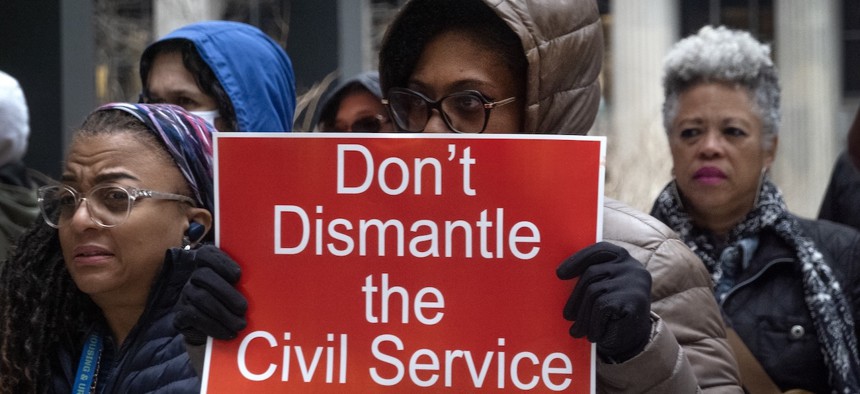
Federal employees rally in support of their jobs outside of the Kluczynski Federal Building in Chicago, on March 19, 2025. The rally was organized by the National Treasury Employees Union to voice concerns about the mass firing of federal workers by the Department of Government Efficiency (DOGE). Scott Olson/Getty Images
Most major agencies are now indefinitely barred from issuing mass layoffs
The Trump administration's plans to reorganize agencies are "likely unconstitutional," judge says.
The Trump administration is indefinitely barred from issuing or finalizing widespread layoffs at most major federal agencies after a judge late Thursday night issued a preliminary injunction finding the president likely acted outside his legal and constitutional powers.
The order extends a two-week temporary restraining order Judge Susan Illston for the Northern District of California had previously put in place and prohibits much of the Trump administration from implementing its planned reorganization efforts. The federal agencies named in the case cannot issue any new reductions in force, nor can they finalize those they have already issued by actually terminating any individual’s employment.
The president must seek congressional authorizations to engage in large-scale reorganizations of agencies, Illston said, something many presidents have done including President Trump in his prior term. Her order specifically pauses any implementation related to Agency RIF and Reorganization Plans, which she called “hastily constructed and likely unconstitutional.” Those plans were required by the Office of Personnel Management and Office of Management and Budget, as well as Trump’s executive order that precipitated them.
Illston privately reviewed several non-public ARRPs and found the agencies themselves often did not suggest any layoffs were necessary, only to be overruled by OPM, OMB and the Department of Government Efficiency. She also noted that many agencies would likely not be able to carry out their statutory duties if the layoff plans were allowed to go through.
The coalition of unions, nonprofits and several states that brought the lawsuit applauded the preliminary injunction.
“The Trump administration’s unlawful attempt to reorganize the federal government has thrown agencies into chaos, disrupting critical services provided across our nation," the group said. "Each of us represents communities deeply invested in the efficiency of the federal government–laying off federal employees en masse and reorganizing government functions haphazardly does not achieve that."
Illston's order tasked impacted agencies with rescinding already issued RIFs and putting those currently on paid administrative leave back on the job, though she immediately paused enforcement of that provision pending the outcome of the case. Her order applies to the departments of Agriculture, Commerce, Energy, Health and Human Services, Housing and Urban Development, Interior, Labor, State, Treasury, Transportation and Veterans Affairs, as well as also OMB, OPM, DOGE, AmeriCorps, Peace Corps, the Environmental Protection Agency, the General Services Administration, the National Labor Relations Board, the National Science Foundation, the Small Business Administration and the Social Security Administration.
The Trump administration has defended the layoffs by arguing the president did not issue mandates for specific actions and OMB and OPM only provided guidance for how agencies should conduct RIFs. Andrew Bernie, a Justice Department attorney representing the government at a hearing on Thursday, said OMB and OPM do not view their roles as “substantively second-guessing agencies determinations.” He added the RIF blueprints were just planning documents and agencies did not have to follow through on them.
Danielle Leonard, an attorney for the plaintiffs, countered at the hearing that her team had presented evidence of OMB and OPM overruling agencies that submitted first drafts of their RIF plans.
“They are saying what to cut, when to cut, where to cut,” Leonard said.
The Trump administration has largely complied with Illston’s order, though some reorganization actions—such as the Interior Department’s efforts to consolidate functions—have continued. Agencies have also moved forward with the re-firings of employees in their probationary periods. Some agencies have notified employees subject to layoffs that those efforts were paused.
The Trump administration previously appealed the judge’s restraining order to both the Ninth Circuit Court of Appeals and Supreme Court, though neither entity has issued a ruling. The Supreme Court on Thursday, however, did rule that Trump could fire leaders of independent federal boards, seeming to break with 90-year precedent and creating what the dissenting justices called possibly “the most subservient” executive branch ever.
Office of Management and Budget Director Russ Vought, who has helped orchestrate the Trump administration’s federal workforce reduction efforts, told reporters on Thursday all of the RIFs across government were conducted legally and predicted the administration would ultimately prevail. “They've been an effort to scale down the federal workforce with care, with wisdom about what's necessary to statutorily conduct and operate agencies,” Vought said. “And I think at the end of the day, wherever they're at, they're going to be successful when they get to the Supreme Court."
The administration has also faced more targeted setbacks: on Thursday, a federal judge in Massachusetts issued a preliminary injunction blocking the Education Department from carrying out its mass layoffs. Other judges have paused RIFs at the Consumer Financial Protection Bureau and the Institute of Museum and Library Studies. The legality of layoffs at the Health and Human Services Department is currently being litigated.
How are these changes affecting you? Share your experience with us:
Eric Katz: ekatz@govexec.com, Signal: erickatz.28
NEXT STORY: More than 2,100 GSA employees have accepted deferred resignations







